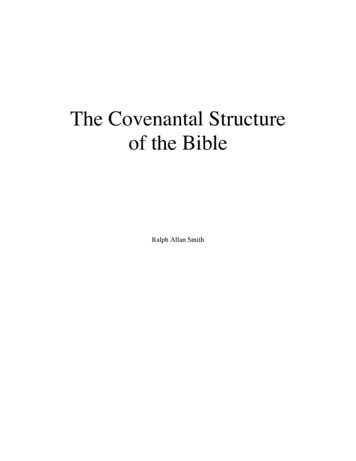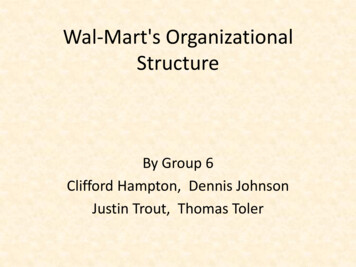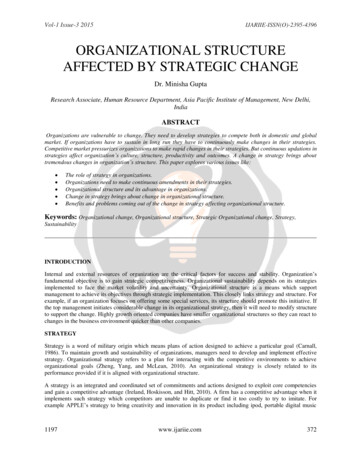
Transcription
The Covenantal Structureof the BibleRalph Allan Smith
The Covenantal Structure of the Bible (revised version) 2006 Ralph Allan SmithCovenant Worldview InstituteTokyo, Japaninfo@berith.orgThis book may freely be copied and distributed under the conditions that the content isnot altered and credit is given to the author.
Table of ContentsChapter One: The Central Theme of the Bible1Chapter Two: What is a Covenant (Part 1)4Chapter Three: What is a Covenant (Part 2)7Chapter Four: The History of the Covenants (Part 1)10Chapter Five: The History of the Covenants (Part 2)14Chapter Six: The Edenic Covenant18Chapter Seven: The Post Fall Promise22Chapter Eight: The Noahic Covenant26Chapter Nine: The Abrahamic Covenant30Chapter Ten: The Mosaic Covenant33Chapter Eleven: The Davidic Covenant37Chapter Twelve: The Restoration Covenant41Chapter Thirteen: The New Covenant46
The Central Theme of the BibleChapter OneWhat is the central theme of the Bible? To answer this question, we must consider onethat is more fundamental: Does the Bible have a central theme? If the Bible is one book, it isapparent that the answer must be yes. Certainly, this is the answer that has been given byChristian people from every land, language, and culture who, for almost 2000 years, haveconfessed that the Bible is a unified revelation from God.More importantly, the Bible itself confirms this testimony. Although written by over 40different authors over a period of about 1500 years, the Bible presents an integrated worldview inits doctrines of God, man, law, history, and salvation. The harmony of the Biblical teaching isall the more wonderful since it represents an organic growth of revelation in the historicaloutworking of God’s covenant relationship with His people from the original creation to the endof the world.Christians from all ages have confessed the unity of the Biblical message, but they havenot all found the unity of the Bible in the same themes. They do not all agree which theme iscentral. Some, for example, have suggested the idea of redemption. Now the Biblical storysurely is the unfolding of a redemptive drama. The Bible tells us how man fell into sin and howGod in His grace saved man (Gen. 3:1-15). It tells us of God’s great love for sinful men and thedeath of Jesus to redeem man (John 3:16). The Bible teaches us that the Holy Spirit was sentinto the world to apply Jesus’ redemptive work (Rom. 8:1-14). At the climax of history, we willsee the world redeemed and the full manifestation of God’s glory (1 Cor. 15:22-28).Thus, redemption is surely one of the grand themes of the Bible. But, redemption does notseem to be a broad enough theme to include all major themes. To be specific it does not seembroad enough to include topics like creation, which occurs before there is any need forredemption and seems to be more important in the Bible than just background information forredemption. It would be difficult with a central theme as narrow as redemption to find a properplace for other themes such as angels, Satan, fallen angels, hell, and so on. As important asredemption is to the Biblical story, it does not seem to be the true organizing center of the Bible.Others have suggested that the central theme of the Bible is Christ Himself. This must betrue in some sense for Christ is the Creator of the world and the Word of God incarnate (John1:1-3). From the fall to the consummation of redemption, the Biblical message centers on theperson of Christ as the Savior of the world. He is prefigured in types and predicted in prophecy(Luk. 24:25-27). Whatever answer one gives to the question of the main theme of the Bible,Christ must be a part of the answer. But in what sense should we think of Christ as the center?Many Bible teachers believe the covenant is the most important theme in the Bible. Again,the covenant is definitely a main theme. The Bible tells the story of God’s covenants with Adamand Christ (Rom. 5:12 ff.). It tells us how Adam broke the covenant and brought the humanrace, which he represented, into sin and judgment. To Noah, Abraham, Moses, and David, Godbestowed covenantal promises that represented a renewal of the covenant with Adam and thepromise of a better covenant to come. That better covenant, of course, is the new covenant inChrist. He came into the world to be our new representative, to succeed where Adam had failed.-1–
The Central Theme of the BibleBy His death on the cross, He redeemed us from sin and judgment — the Adamic curse. In Hisresurrection, we receive life. Thus, from creation to redemption, the whole Biblical message iscovenantal.Like redemption, the covenant is definitely a unifying theme of the Bible, but it also seemsto be inadequate to bring together the full range of Biblical revelation. By itself, the notion ofcovenant tends to be abstract and difficult to define. What we need is a theme that is broadenough to embrace every major Biblical idea, a theme that includes redemption, gives properhonor to Christ as the Creator and Savior, and also does justice to the centrality of the covenant.Such a theme is the kingdom of God. In the kingdom of God, all of the other suggestedmajor themes are included and given proper place. In addition, the kingdom of God includesother themes important for our understanding of the Bible, such as creation, the Biblical teachingabout angels and demons, the doctrine of final judgment and everlasting punishment. ChristHimself remains a central theme of the Bible because as the King, He is the center of thekingdom, its very essence. Redemption as a central theme is the unfolding drama of God’srestoring the kingdom to its original purpose.Also, the theme of the covenant finds its proper place when we recognize that the covenantis the constitution of the kingdom, the definition of the Heavenly King’s relationship to Hispeople. In the Biblical story, kingdom and covenant are almost synonymous and at leastmutually dependent conceptions. The covenant defines and establishes the kingdom; thekingdom in its essence is an extended covenantal relationship.Genesis begins with the creation of the kingdom of God and the rebellion of man underSatan. The rest of the Bible tells how God restores the kingdom to Himself and brings man backinto the position of kingdom glory that God originally designed for him. History is the story ofGod’s war against Satan. God defeats Satan and reconstructs His kingdom through Christ,bringing to pass His original purpose for the creation.The Gospel that Christ preached was the Gospel of the kingdom of God: “And Jesus wentabout all Galilee, teaching in their synagogues, and preaching the gospel of the kingdom, andhealing all manner of sickness and all manner of disease among the people” (Mt. 4:23; cf. 9:35;4:17; 5:3, 10; 6:33; 10:7; 12:28; 13:11ff.; 16:19, 28; 18:3-4; 19:14; 21:43; 24:14; 25:34). Paul,the great apostle, preached the message of the kingdom: “And Paul dwelt two whole years in hisown hired house, and received all that came in unto him, preaching the kingdom of God, andteaching those things which concern the Lord Jesus Christ, with all confidence, no manforbidding him” (Ac. 28:30-31; cf. 14:22; 19:8; 20:25; 28:23). The last book in the Biblecelebrates the everlasting establishment of God’s kingdom: “And the seventh angel sounded;and there were great voices in heaven, saying, The kingdoms of this world are become thekingdoms of our Lord, and of his Christ; and he shall reign for ever and ever” (Rev. 11:15; cf.1:9; 12:10). The last chapters of the book of Revelation describe the new Jerusalem, theheavenly city, the fulfillment of God’s purpose for the creation and the final manifestation of thekingdom of God (Rev. 21-22).Christ as the head of the new covenant brings in the kingdom of God, fulfilling thepromises made to Abraham and David, accomplishing all that God had designed for man in theoriginal creation. Satan’s attempt to destroy the kingdom is defeated by the Messiah who savesthe world and establishes the everlasting kingdom.Thus, the covenantal kingdom of God is the central theme of Biblical revelation. All theother suggested central themes find their proper place within this theme, for the covenant is the-2-
The Central Theme of the Bibleconstitution of the kingdom, Christ is the king, and redemption is God’s work of restoring thekingdom so that man as God’s viceregent may fulfill his original purpose.-3-
What is a Covenant? (Part 1)Chapter TwoWhen we say that the kingdom of God is a covenantal kingdom, we refer to the fact thatthe covenant defines God’s relationship with man and therefore, the covenant is the“constitution” of the kingdom. But, we must consider more specifically what a covenant is. Tobegin with, we must understand the essence of the covenant, for it is often misunderstood.Sometimes even Biblical scholars erroneously state that the covenant idea in the Bible isessentially the same as the idea of a contract. This is not true. Contract and covenant differ intheir very essence. A contract is a conditional relationship established for the mutual benefit ofthe contracting parties. A contact is a limited commitment, continuing only so long as themutual benefit continues. The covenant is not a contractual type of relationship, limited by themutual benefit of the parties involved.To discern the essence of a covenantal relationship, we need only to consider the book ofDeuteronomy, one of the first books of the Bible and one that emphasizes the covenant.Deuteronomy shows clearly that the essence of the covenant is love. First, God’s love for Hispeople is the basis for His calling them. Then, they are urged to respond to Him in love,expressed by loyalty to the covenant established with God.For you are a holy people to the LORD your God; the LORD your God has chosenyou to be a people for His own possession out of all the peoples who are on the faceof the earth.The LORD did not set His love on you nor choose you because you were more innumber than any of the peoples, for you were the fewest of all peoples, but becausethe LORD loved you and kept the oath which He swore to your forefathers, theLORD brought you out by a mighty hand and redeemed you from the house ofslavery, from the hand of Pharaoh king of Egypt. Know therefore that the LORDyour God, He is God, the faithful God, who keeps His covenant and Hislovingkindness to a thousandth generation with those who love Him and keep Hiscommandments; but repays those who hate Him to their faces, to destroy them; Hewill not delay with him who hates Him, He will repay him to his face. Therefore,you shall keep the commandment and the statutes and the judgments which I amcommanding you today, to do them.Then it shall come about, because you listen to these judgments and keep and dothem, that the LORD your God will keep with you His covenant and Hislovingkindness which He swore to your forefathers. He will love you and bless youand multiply you; He will also bless the fruit of your womb and the fruit of yourground, your grain and your new wine and your oil, the increase of your herd and theyoung of your flock, in the land which He swore to your forefathers to give you.(Deu. 7:6-13)-4-
What is a Covenant (Part One)In these verses we see that the origin of the covenant is the love of God for Abraham andhis seed. God determined to bless the children of Israel and to make them His own people. Hedid not choose them as if He were getting “a good deal.” There is nothing contractual here. Ingrace, He determined to love them and to bestow His blessing upon them.But love requires mutuality. It is a two-way street. So, God demands that the children ofIsrael also love Him.Hear, O Israel! The LORD is our God, the LORD is one! You shall love the LORDyour God with all your heart and with all your soul and with all your might. (Deu.6:4-5)Now, Israel, what does the LORD your God require from you, but to fear the LORDyour God, to walk in all His ways and love Him, and to serve the LORD your Godwith all your heart and with all your soul, and to keep the LORD’S commandmentsand His statutes which I am commanding you today for your good? (Deu. 10:12-13)As these verses make clear, a covenant is a commitment of love. Since it creates arelationship fundamentally different from the mutual profit-seeking relationship of a contract, itmust be established in a different manner. In the Bible, a covenant can only be established andsealed by an oath, which usually involves an oath-taking ceremony like circumcision (that is, inancient Israel, the act of circumcising a child constituted a covenant oath). The oath is soimportant in a covenant that the word oath is sometimes used as a synonym for covenant (cf.Deu. 29:12, 14).What then is an oath? An oath is a self-maledictory promise. When one takes an oath, hepromises to preserve the covenantal relationship and seals the promise with words that call acurse upon himself if he should fail to keep his promise. The curse of the covenant is death.Many Christians may not realize that a curse is part of the traditional Christian weddingvow. “Till death do us part” means “until death,” but it includes the idea that nothing but deathcan end the covenant, implying the curse of death on the one who is disloyal to the oath.Another aspect of the traditional wedding vow illustrates the type of commitment demanded in acovenant. For example, we say “in sickness and health,” and “for better or worse,” whichwitness to the fact that even if the relationship turns out to be “unprofitable” for us, we will notabandon our partner because of economic or other adversities. Marital love is self-sacrificial.There is no basis for dissolving the relationship unless one of those who took the vow betrays itand undermines the whole relationship. Sickness, poverty, or an unpleasant personality cannotundo the oath. In marriage, each person takes an oath to give himself or herself sacrificially tothe other, without thought of personal profit.The wedding illustration is especially appropriate, for God’s relationship with Israel iscompared to the relationship of husband to wife (Ezek. 16). So long as Israel is faithful to thelove of the covenant — and “faithful” here does not mean sinless perfection, but rather repentantfaith and love — God will never leave her or forsake her. His commitment to bless her cannotbe shaken.But, it is not in God’s relationship with Israel that we see the full meaning of love, for theBible does not unfold the full meaning of covenantal love until the advent of Christ. It is in therelationship between Christ and the Father, that we first see that covenantal love is the eternalfellowship of Father, Son, and Spirit.-5-
What is a Covenant (Part One)Father, I desire that they also, whom You have given Me, be with Me where I am, sothat they may see My glory which You have given Me, for You loved Me before thefoundation of the world. . . . and I have made Your name known to them, and willmake it known, so that the love with which You loved Me may be in them, and I inthem. John 17:24-26In the relationship of Christ and the Father, we understand that John’s words “God is love”have Trinitarian significance. God is love because the Father, Son, and Spirit share aneverlasting love for one another. Each of the three Persons of the Trinity wholly devotesHimself to bless and glorify the other (cf. John7:18; 8:50, 54; 11:4; 12:28; 13:31-32; 14:13;16:14;17:1, 4, 5, 22, 24). God Himself in the fellowship of Trinitarian love is the ultimatekingdom, and the relationship between the Persons of the Trinity is the true covenant.This has profound significance for the Biblical story of creation and redemption. Godcreated the world as His kingdom to manifest His glory (cf. Psa. 8, 19). Since the three Personsof the Trinity constitute a covenantal kingdom of love, the created world, too, is a covenantalkingdom over which God set Adam and Eve to rule. Their rule was to be based upon love forGod and one another. They were to guard the created world and take care of it so that it wouldbear fruit for God’s glory (Gen. 2:15). The fall of man was a rejection of God’s love and arejection of the way of love among men. The violence of the pre-flood world is the climax of therebellion of the fall and the logical outcome of the rejection of God’s love.Redemption means the restoration of the covenantal purpose of God. Man is restored tohis original calling as God’s image, which means man is called back into the fellowship of thecovenantal love of the Father, Son, and Spirit. The created world, too, must be restored to itsoriginal purpose of revealing God’s glory through the covenantal stewardship of God’s image.The kingdom of righteousness and love must come to historical realization in order that Satan’slie and the temptation in the Garden may be utterly defeated to the glory of God. Redemptionfinds its fulfillment in the kingdom of God. God has poured out His covenantal love upon us inJesus Christ in order that through faith in Him we may be re-created as His children and broughtinto an everlasting fellowship of love.The Bible is the story of God’s covenantal kingdom — its creation, its corruption by sinand folly, and God’s gracious redemption of that kingdom to the praise of the glory of His grace.The central theme of the Bible, the covenantal kingdom of God, reveals the nature of the TriuneGod as a God of love who has called man into a fellowship of love with Himself.-6-
What is a Covenant? (Part 2)Chapter ThreeThe essence of God’s covenant is love, but the idea of a covenant also implies a formalrelationship. The mutual commitment of a love relationship is sometimes expressed in a legalform that makes the obligations of love explicit. A covenant is such a formal love commitment.Again, the analogy of marriage is helpful. The fact that a wedding vow is a legalceremony does not detract from the love which it expresses. On the contrary, if a man professesto love a woman, but he refuses to assume legal obligations, the reality of his love is dubious atbest. God’s love for man is expressed in the legal form of a covenant in which God takesobligations upon Himself and calls man to be loyal to the covenant. The covenant, therefore, hasa clear structure and may be expressed in formal legal language. The book of Deuteronomy, thebook of covenant love, provides us with our understanding of the covenant. The whole book is acovenantal document, structured in terms of a five-point outline that is used throughout the Bibleto define the covenant. Ray Sutton explains the outline of Deuteronomy as follows.Transcendence (Deut. 1:1-5). The covenant begins with an acknowledgment ofGod’s absolute Lordship. He grants the covenant. He is the absolute King.Hierarchy (Deut. 1:6-4:49). In this section of Deuteronomy, Moses describes thehistory of Israel in terms of God’s leading and blessing. God gave Israel leaders,covenantal representatives. When Israel was faithful to God, she obeyed her leaders.Ethics (Deut. 5-26). The central section of the covenant defines how God’s peopleare to live so that they can be His holy nation. God’s relationship with His people isan ethical relationship. They must be righteous to enjoy the blessings of thecovenant.Oath (Deut. 27-30). The covenant promises blessings for those who obey the lawand curses for those who rebel. When God’s people take the oath of the covenant,they call upon God to curse them if they disobey and to bless them if they obey.Succession (Deut. 31-34). The final section of the covenant concerns the heirs of thecovenantal blessings. God intends for the covenant to continue from generation togeneration in godly families. Training children to follow God and working to passthe blessing on to the future is essential to true covenantal obedience.1Of course, the five-point outline is not the only outline of the covenant that has Biblicalvalidity. James Jordan, in an inductive study of Leviticus and Deuteronomy, suggests thatthreefold (Trinity), fourfold (world foundations), fivefold (housebuilding), sixfold (man),1Sutton’s original outline did not spell the word THEOS as the outline above, but the points are the same.See, Ray Sutton, That You May Prosper (Tyler, Texas: Institute for Christian Economics, 1987).-7–
What is a Covenant (Part 2)sevenfold (Sabbath), tenfold (law), and twelve-fold (covenant people) organizations of thecovenant material are also possible.2 However, although Jordan does not believe that thedivision of the covenant into five parts has any actual priority over other possible outlines, heshows that a five-point outline is used most frequently by Moses and is not an arbitrary inventionof expositors.3Also, the ten commandments, according to North,4 Sutton,5 and Jordan,6 are structured as atwofold repetition of the five point covenant outline.1. The first commandment, by teaching that God alone is to be worshiped, calls us tohonor the transcendent Creator and Redeemer. By forbidding murder, the sixthcommandment protects the image of the transcendent God.2. The second commandment and the seventh are related throughout the Bible in theconnection between idolatry and adultery. Both sins are perversions of submissionto the God-ordained order.The third section of the covenant, ethics, has to do with boundaries, which is also thepoint of the eighth commandment: “Thou shalt not steal.” The third commandmentdemands that we wear the name of God righteously – a call to obey His law wherebywe show the glory of His name in our lives.4. The fourth and the ninth commandments are both concerned with sanctions sincethe Sabbath is a day of judgment in which man brings his works to God forevaluation; the command not to bear false witness views us in the courtroomparticipating in the judicial process.5. The fifth and tenth commandments correspond to the fifth part of the covenant,inheritance/continuity. In the fifth, children, the heirs to be, are told how to obtain aninheritance in the Lord. In the tenth, we are forbidden to covet, a sin that leads to thedestruction of the inheritance in more ways than one.We have seen that the five-point outline of the covenant is 1) actually the outline ofDeuteronomy, 2) repeatedly used in Leviticus and Deuteronomy, and 3) the structural outline forthe ten commandments. Thus, it may be used as a tool for Biblical exegesis and relating thecovenant to the concrete details of daily life. Jordan lists the five points in broad terms that makethe broader implications of each point clear.2James B. Jordan, Covenant Sequence in Leviticus and Deuteronomy (Tyler, Texas: Institute for ChristianEconomics, 1989), pp. 3-6. Jordan also suggests a threefold approach to the covenant in, The Law of the Covenant(Tyler, Texas: Institute for Christian Economics, 1984), p. 7: “In summary, the covenant has three aspects. There isa legal bond. There is a personal relationship. There is a structure within the community.” He develops a four pointand a twelve point approach in Through New Eyes, pp. 130-31.3Covenant Sequence in Leviticus and Deuteronomy, p. 6, 9-10.4Gary North, The Sinai Strategy: Economics and the Ten Commandments (Tyler, Texas: Institute forChristian Economics, 1986).5Op. cit. pp. 214-24.6Op. cit. pp. 10-13.-8–
What is a Covenant (Part 2)1. Initiation, announcement, transcendence, life and death, covenantal idolatry.2. Restructuring, order, hierarchy, liturgical idolatry, protection of the bride.3. Distribution of a grant, incorporation, property, law in general as maintenance ofthe grant.4. Implementation, blessings and curses, witnesses, Sabbath judgments.5. Succession, artistic enhancements, respect for stewards, covetousness.7We will use this five-point outline of the covenant to help analyze the various covenants inthe Bible so that we may obtain a detailed understanding of each covenantal era. While thegeneral structure of the covenant is the same, covenant revelation grows over time. To see theimplications of the covenant for each era and observe the growth of the covenant, it is helpful toconsider each point in every Biblical covenant.As we shall see, the first point, the Lordship of the Triune God, is essentially the same ineach covenant. However, God reveals Himself in each covenant in different ways so that Hispeople come to a deeper understanding of Him. The second point concerns the representativesystem established on earth. In each age there are representatives in church, state, and familywho are God-appointed leaders for His people, but the details of the system change in differentages. The third point covers the detailed commands for daily life that God gives to His people.These, too, vary from age to age, though the heart of the righteous demand of the law of God isunchanging. Righteousness always means love, and the specific obligations of love are definedby the nature of the personal relationship, for example, father-child, husband-wife, brotherbrother, etc. The fourth point, blessings and curses, varies, depending on the actual situation ofthe people of God. Also, the fourth point deals with covenantal ceremonies, our renewal of thecovenant oath, the details of which change a great deal from covenant to covenant. The fifthpoint which deals with inheritance, varies with the second and fourth points in accordance withthe covenantal situation of the people of God. Before we consider each covenant era in detail, itis important to grasp of the overall covenantal structure of the Bible.7Covenant Sequence in Leviticus and Deuteronomy, p. 14.-9–
The History of the Covenants (Part 1)Chapter FourThe doctrine of the covenant structures the Biblical story. In the beginning, God createdman and the whole world in a covenant relationship with Himself, placing Adam in the Gardenof Eden, the sanctuary of the world. There, Adam was to enjoy God’s highest covenant blessing,fellowship with God Himself. But, Adam broke the covenant on the very first Sabbath day. Thiscould have been the end of the story, but God is a God of grace. He renewed His covenant withman and promised to establish a wholly new covenant through a new Adam (Gen. 3:15). Thepromised Savior would be the Head of a new humanity that would fulfill the purpose of God increating the world as His kingdom (cf. Rom. 5:12-25).When we read Genesis 1-3, we see how man rebelled against God, but the word“covenant” is not actually used in these chapters. How, then, do we know that Adam’srelationship with God was covenantal? We understand that the original relationship was acovenant because we see all the elements of the covenant in the narrative and because Hoseaexplicitly refers to this arrangement as a covenant (Hos. 6:71). Furthermore, when the wordcovenant is first used in the Bible in Genesis 6:18 and 9:9-17, the repetition of the same languagethat occurs in the first chapters of Genesis clearly indicates that the covenant with Noah is aredemptive renewal of the original covenant with Adam.And God blessed Noah and his sons, and said unto them, Be fruitful, and multiply,and replenish the earth. And the fear of you and the dread of you shall be upon everybeast of the earth, and upon every fowl of the air, upon all that moveth upon theearth, and upon all the fishes of the sea; into your hand are they delivered. Everymoving thing that liveth shall be meat for you; even as the green herb have I givenyou all things. But flesh with the life thereof, which is the blood thereof, shall ye noteat. And surely your blood of your lives will I require; at the hand of every beastwill I require it, and at the hand of man; at the hand of every man’s brother will Irequire the life of man. Whoso sheddeth man’s blood, by man shall his blood beshed: for in the image of God made he man. And you, be ye fruitful, and multiply;bring forth abundantly in the earth, and multiply therein. (Gen. 9:1-7; cf. Gen.1:26-28)The original covenant with Adam is the basic covenant for the entire era that begins withthe creation and lasts until the incarnation of Christ. Paul points to this when he explains thewhole history of the world in terms of two men, Adam and Christ (Rom. 5:12-21; 1 Cor. 15:2249). Adam was the head of the old covenant. Christ is the Head of the new covenant. Adamwas the viceregent of God who failed and led his sons into sin (Rom. 5:12). Christ is theviceregent of God who kept God’s covenant and won the blessing, both for Himself and for Hisseed (Rom. 5:19; cf. Isa. 53:10-12).1The correct translation of Hosea 6:7a is: “But they like Adam have transgressed the covenant . . .” See,Benjamin B. Warfield, “Hosea VI.7: Adam or Man?” in Shorter Collected Writings, vol. 1, pp. 116 ff.- 10 -
The History of the Covenants (Part 1)The Bible records six additional covenants from the time of Adam’s fall until the advent ofChrist. These covenants are secondary — renewals and extensions of the covenant with Adam,each of which underscores a particular aspect of man’s responsibility as God’s image. In theGarden, Adam was a priest whose responsibility was to guard the Garden and his wife Eve (Gen.1:15-25). He was also a king who was given dominion over the world (Gen. 1:26-28). And hewas a prophet to whom God spoke (Gen. 1:16-17). But, Adam was also immature, which iswhat is symbolized by the nakedness of Adam and Eve at creation. Because of Adam’s fall, theprogress of the covenant after him is based upon God’s redeeming grace. Despite man’s sin,God works in history to reveal Himself through His covenant love. In redemptive grace, Godleads man from immaturity in the Garden through a covenantal process of growth, leading tomaturation in Christ.The six “sub-covenants” in the old covenant era develop in two cycles from priestly tokingly to prophetic. These “sub-covenants” are new versions of the original Adamic covenant,rather than entirely new or independent covenants. Each of these covenants renews the Adamiccovena
Many Bible teachers believe the covenant is the most important theme in the Bible. Again, the covenant is definitely a main theme. The Bible tells the story of God’s covenants with Adam and Christ (Rom. 5:12 ff.). It tells us how Adam broke the covenant and brought the










